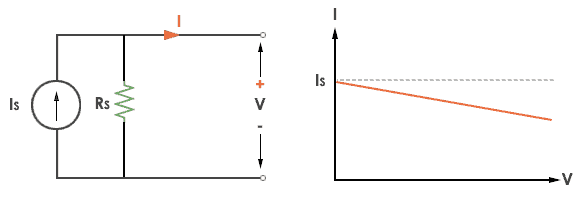Ideal Voltage Source:
An ideal voltage source is capable to maintain the constant voltage across its terminals. The voltage across the voltage source terminals remains constant and the voltage is independent of the current. An ideal voltage source must have zero internal resistance. Hence, the voltage across the load will be equal to the voltage across the terminals of the voltage source.
The fig. 1(a) shows voltage source and 1(b) shows its output characteristic
Practical Voltage Source:
Voltage Sources having some amount of internal resistances connecting in series is known as Practical Voltage Source. Due to this internal resistance; voltage drop takes place, and it causes the terminal voltage to reduce. The smaller is the internal resistance (r) of a voltage source, the more closer it is to an Ideal Source.
Ideal Current Source
An ideal current source that is capable of providing a constant current output regardless of the load resistance. An ideal current source is a circuit element that maintains a prescribed current through its terminals regardless of the voltage across those terminals.
- It produces a constant current value irrespective of the voltage across it.
- i.e., i=is for all V
Practical current source
A practical current source is represented as an ideal current source connected with resistance in parallel.

The graph represents the current of the current source with respect to time. It is not constant but it also keeps on decreasing as the time passes.
A practical current source is represented as an ideal current source connected with resistance in parallel.

The graph represents the current of the current source with respect to time. It is not constant but it also keeps on decreasing.








